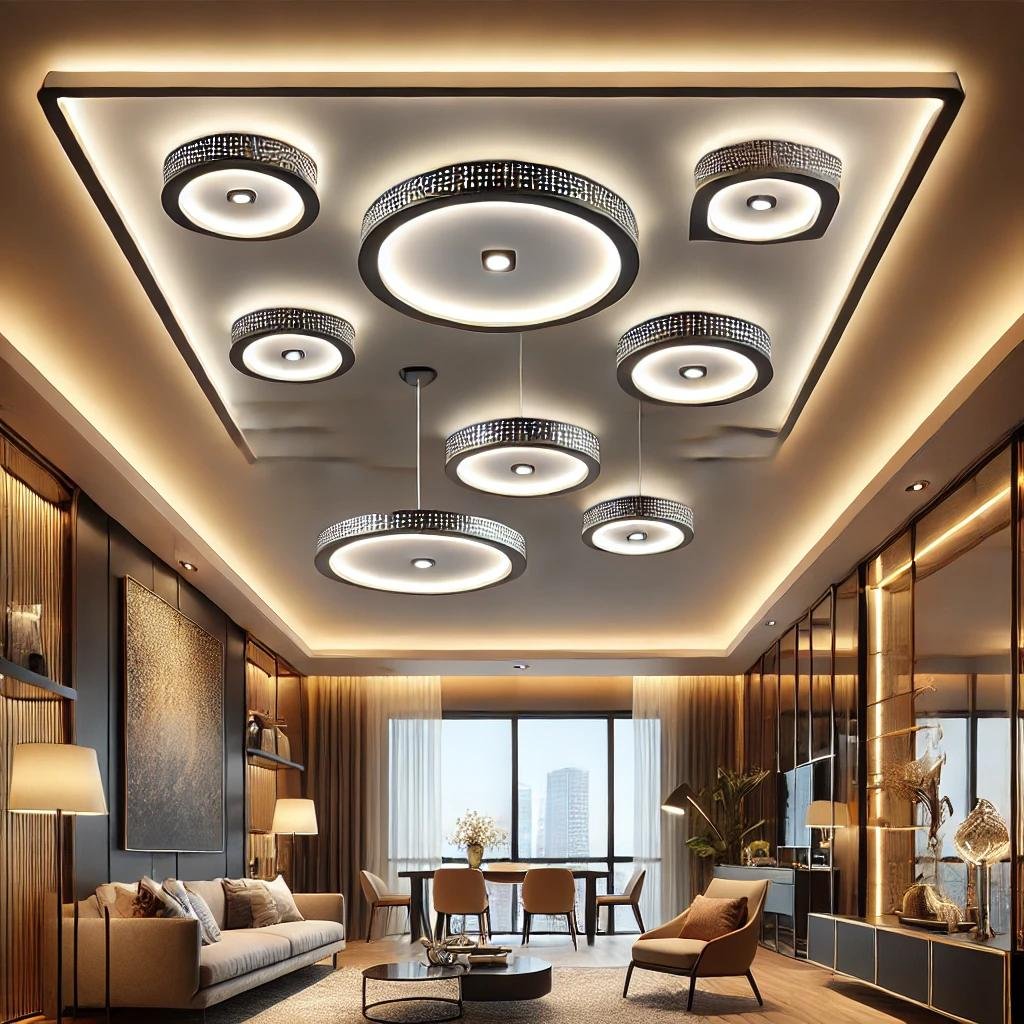Overview
Modern households and companies now generally use LED ceiling lights as their lighting source. Their preferred option over conventional incandescent and fluorescent lighting is their energy efficiency, lifetime, and elegant designs. LED ceiling lights provide the ideal mix of looks and utility whether your project is rebuilding an office, updating the lighting in your house, or seeking a chic but useful solution.
This all-inclusive guide covers all you need to know about LED ceiling lights, including their advantages, varieties, installation advice, and main points of consideration for purchases.
Why Choose LED Ceiling Lights?
Impressive benefits of LED ceiling lights are transforming interior lighting:
1. Energy Efficiency
LEDs use far less energy than either incandescent or fluorescent lights. Their conversion of most of the electricity into light instead of heat helps to lower energy costs.
2. Extended Lifespan
Up to 25 times longer than conventional bulbs, a premium LED ceiling light will run 50,000 hours or more.
3. Environmentally Friendly Choice
LEDs are a safer and more ecologically friendly substitute since they do not include dangerous elements like mercury.
4. Variety in Designs and Styles
LED ceiling lights come in numerous styles, including flush mount, recessed, pendant, and panel lights, allowing homeowners to choose fixtures that complement their interior decor.
5. Enhanced Brightness and Color Temperature Control
From warm ambient lighting to cool task lighting, LEDs are flexible for many environments since they provide changeable brightness levels and color temperatures.
LED Ceiling Lighting Types
Your space, style, and functional requirements will determine the correct kind of LED ceiling light you need. The most common forms are:
1. LED Ceiling Lights Flush Mount
- Perfect for limited ceilings and small areas.
- Designed in elegant, contemporary style.
- Offer even and wide illumination.
2. Downlight Recessed LED Lights
- Installed on the ceiling for a simple, understated look.
- Perfect for offices, bathrooms, and kitchens.
- Often included in layered lighting arrangements.
3. Pendant LED Ceiling Lights
- Hang from the ceiling as visual focal points.
- Best suited for dining rooms, kitchens, and living areas.
- Available in various styles, from industrial to modern.
4. LED Panel Lights
- Used in commercial settings and modern homes.
- Offer consistent brightness and glare-free illumination.
- Typically installed in drop ceilings.
5. Chandeliers with LED Technology
- A blend of classic elegance and energy efficiency.
- Available in traditional and modern designs.
- Perfect for stately foyers, dining spaces, and luxury settings.
Factors to Consider When Buying LED Ceiling Lights
1. Brightness and Lumens
LED brightness is measured in lumens (lm), not watts. Select a brightness level depending on the dimensions of your space:
- 1,000–2,000 lumens: Small rooms or accent lighting.
- 2,000–4,000 lumens: Medium-sized offices or bedrooms.
- 4,000+ lumens: Large areas like commercial offices or living rooms.
2. Color Temperature
- Warm White (2700K–3000K): Cozy, ambient lighting.
- Cool White (4000K–5000K): Bright and clear task lighting.
- Daylight (5000K–6500K): Best for offices and production areas.
3. Dimmability
Many LED ceiling lights have dimming capabilities, allowing you to adjust brightness levels for various moods and events.
4. Installation and Compatibility
- Ensure your wiring configuration and ceiling type match.
- If you plan to DIY, choose easy-to-install fixtures.
5. Smart Features
- LED lights with Wi-Fi enable smartphone app remote control.
- Compatible with Alexa, Google Assistant, or Apple HomeKit for smart home voice commands.
LED Ceiling Lights Installation Advice
1. Turn Off Power Before Installation
Always switch off the electrical supply before installing new lights to ensure safety.
2. Choose the Right Location
Position ceiling lights for even brightness, considering room size and lighting needs.
3. Use the Proper Tools
Installation typically requires a screwdriver, drill, and wire connectors.
4. Verify Compatibility and Wiring
Ensure the new LED light fits your existing wiring to prevent issues.
5. Seek Professional Help If Needed
For complex installations, hiring an electrician is advisable.
FAQs Regarding LED Ceiling Lights
READ ABOUT-The Ultimate Guide to Electric Lighters: How They Work and Why You Need One
1. Are LED ceiling lights better than other bulbs?
Yes, LED ceiling lights are a cost-effective and eco-friendly option, excelling in energy efficiency, longevity, and brightness control.
2. How long do LED ceiling lights last?
LED ceiling lights typically last 50,000 hours or more, meaning they can run for years before needing replacement.
3. Can I install LED ceiling lights myself?
Yes, many LED ceiling lights come with DIY installation kits. However, for complex wiring setups, professional installation is recommended.
4. Are LED ceiling lights dimmable?
Many LED ceiling lights support dimming, but ensure your dimmer switch is compatible with LED bulbs.
5. Can LED ceiling lights work with smart home systems?
Yes, many LED ceiling lights offer Bluetooth and Wi-Fi connectivity, enabling integration with smart home assistants like Google Assistant and Alexa.
In Essence
LED ceiling lights offer an unbeatable combination of style, efficiency, and functionality. These lights save money and provide long-lasting performance whether you are lighting a house, business, or office. Finding the ideal LED ceiling lamp has never been easier with various styles, brightness settings, and smart features.
For the latest trends and best deals on LED ceiling lights, browse trustworthy retailers such as Amazon, Home Depot, and Lowe’s.

